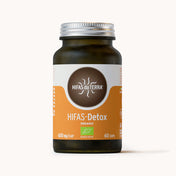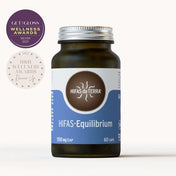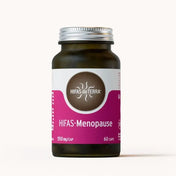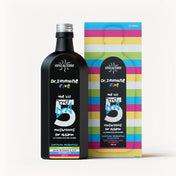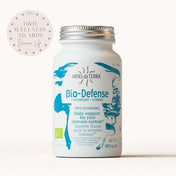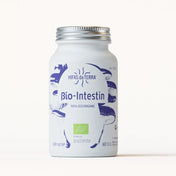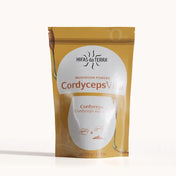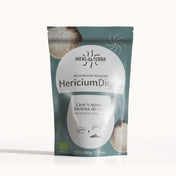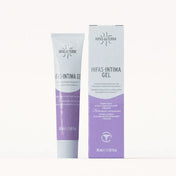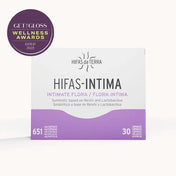The histamine It is one of the substances behind many of the processes related to seasonal allergies, the urticaria, nasal drip, excess mucus and allergic inflammation. According to research carried out, it constitutes a fundamental mediator of the allergic response. Let's see why.
It is also considered a pro -inflammatory enzyme responsible for allergic reactions, rhinitis, dermatitis, migraines and is studied as Risk factor in inflammatory processes that affect the intestines and even the joints.
Enzymes Dao (Diamino oxidase) and catalase intervene in the complete degradation of histamine. In general, problems derived from excess histamine derive from excess histamine in the organism's tissues and poor degradation by the enzyme Dao At the intestinal level.
There are natural supplements that can help with the effects of histamine and allergies Are you interested? Click here
Update: March 2023/Publication: 05/06/2019
Authorship and Edition: Hifas Da Terra communication
REVIEW: RIE+D HIFAS DA TERRA
Content index
- What functions does histamine have?
- Why are histamine liberating foods talk
- High foods in histamine
- What to eat to lower histamine
- Home remedies ’to lower histamine
- Histamine symptoms: What are its effects?
- What inflame the histamine
- What are antihistamines
- Why is it talk about histamine in allergy
- The best natural antihistamines
- Why is the relationship between histamine, allergies and digestive system talk?
- The influence of histamine in the development of migraines
- References
Note: At the biochemical level, histamine (C5H9N3) is classified as an amine (it has the structure of the ammonia (NH3) And it is formed from the elimination, in the form of co2, of carboxyl compounds of the amino acid histidine.
What functions does histamine have?
According to the Spanish Society of Clinical Immunology, Allergology and Pediatric Asthma (SEICAP) On their website, when a person reacts to common allergens such as pollen, mites, etc. produces IgE antibodies (immunoglobulin e) Against that substance.
If said allergen penetrates the body, the antibodies bind to it and can trigger the release of substances such as the histamine, which would be responsible for the appearance of symptoms such as cough, aphonia, pitos, sneezing, itching, tear, eye redness, hives, inflammation…
Why are histamine liberating foods?
One of the guides prepared by the SEICAP indicates that certain foods that contain vasoactive amines Like histamines that can trigger symptoms that, without being, could be confused with an allergic reaction. In short, they release histamines, but they are "Falsely allergizers". Some examples cited are:
- tuna
- chocolate
- strawberries
- tomato
High foods in histamine
On the other hand, there are foods that do contain histamine (it is determined in mg/kg) but the content varies according to the sources consulted. However, in all lists the foods rich in histamine are the ones that follow:
- Alcoholic beverages
- Canned blue fish
- Seafood
- Embutidos
- Cured cheeses
- Fermented products
- Chocolate
- Fruits: citrus, kiwi, strawberries, pineapple, papaya
- Tomatoes
- Eggplants
- Eggs (especially the clear one)
What to eat to lower histamine
Thus, a low histamine diet could include the following foods:
- Legumes
- Fruits: Red fruits, watermelon, apricot, peaches, grapes, grenades, apples, pears, figs ...
- Milk and goat and sheep derivatives
- Integral cane sugar
- White fish
- Squid
- Green leafy vegetables: lettuce, escarole, endive, etc. (Avoid spinach). Zucchini, pumpkin, cauliflower, beans, celery, brécol, Lombarda ...
- Algae
- Seeds
'Home remedies' to lower histamine
One of the most common doubts is what to do or what to reduce the impact of histamine but Are there foods and/or compounds with antihistamine abilities?
Beta-glucanos
These compounds polysaccharides present in foods such as mushrooms, determined cereals and algae They have been studied for their action on the immune system, fundamentally.
In a study published by the magazine Food Science & Nutrition It was observed that Complementation with formulas with beta-glucans reduced allergy symptoms by 28% and their severity by 52%.
In the conclusions of this study, general improvements indicated by the trial participants were also indicated. These pointed out improvements in sleep disorders, energy levels and reduction of symptomatology related to nasal dripping, eye redness, congestion, etc.
Mico-Sol It is the nutritional complement of Hifas da Terra made with pure mushroom extract of the Sun, one of the medicinal fungi with more beta-glycan and mineral content of interest in the control of histamine and other seasonal reactions.
Bromalaína
A study published in 2013 demonstrated that this enzyme is present could reduce the awareness of allergic processes in which the airways are involved thanks to its antiallergic and anti -inflammatory action.
Quercitin
This compound is found in many foods of plant origin, but highlights, above all, in brécol, apples, grapes and tea. Quercitin stands out for its antioxidant capacity. According to the study Quercetin and its anti-allergic Immune Response, Posted in 2006, Quercitin It can reduce the release of histamine and contribute to the reduction of inflammatory processes.
Vitamin c
Several studies have evaluated the relationship between vitamin C and histamine metabolism. An article published in 2015 indicates that ascorbate has a unique capacity to degrade this substance. Previous publications on human trials reflect that Vitamin C taking significantly descends histamine levels in plasma. In animal models, the decrease in bronchonstriction caused by histamine has even been documented.
Histamine symptoms: What are its effects?
In the article Histamine and intercellular communication: 99 years of history The evidence of greater relevance carried out by the scientific community is collected, since in 1910 the English Dale and Laidlaw extract the histamine of the Cornez of Centeno.
As we explain, When cells release histamine, this binds to its receptors and produces different types of responses according to the receptor that activates and the affected tissue. We already mentioned the Nasal drip, itching and hives, but it is not the only associated symptomatology. Through four type of histamine receptors in our body, we can see Other effects resulting from its release:
H1. Where is located: smooth muscle, endothelial cells, marrow of the adrenal glands, heart and CNS
Main effects of receiver activation: allergic responses, smooth muscle contraction, hormone release and regulation of the vigil-sueño cycle
H2. Where is located: Parietal gastric cells, smooth muscle, suppressive cells T, neutrophils, heart, uterus and CNS
Main effects of receiver activation: stimulation of gastric acid secretion, smooth muscle relaxation
H3. Where is located: CNS and nerves of the heart and gastrointestinal tract
Main effects of receiver activation: Inhibition of synthesis and liberation of histamine and other neurotransmitters
H4. Where is located: bone marrow, leukocytes, neutrophils, eosinophils, mast cells and lungs
Main effects of receiver activation: Immune responses, eosinophilous chemotaxis and mastoid cells, cytokine and chemiocin production
Source: Role of histamine in modulating the Immune Response and inflammation, 2018 (Figure 2). This image represents the inflammatory and regulatory functions of histamine. The red arrows indicate a pro -inflammatory action, while the green ones reflect the regulatory action.
What inflame the histamine
The investigations carried out in the 30s of the last century allowed progress in the development of the first antihistamines, the drugs that block the effects of histamine, but also allowed to discover more details about histamine. He sedative effect derived from them served to determine that the histamine Not only does it have to do with the immune response, but also intervenes in the central nervous system (SNC), where it participates in the regulation of various functions such as sleep, locomotive activity and even memory and learning.
What are antihistamines
These drugs base their effect, fundamentally, on the blocking of H1-type histamine receptors that, as we saw, has consequences on the allergic response, the contraction of the smooth muscle, the release of hormones and the regulation of the vigil-sueño cycle.
First and second generation antihistamines
The First generation They are lipophilic drugs, capable of easily entering into the cells. Consequently, its absorption and metabolization is rapid, so they must frequently be administered, 4 and 4 times a day. They also cause important side effects, such as sedation and seizures.
On the other hand, the second generation They have developed in the last 25 years. Some derive from the first generation, but with a clear difference: the reduction of the sedative effects and anticholinergic. Despite this, they are not exempt from side effects, especially if they are administered with other drugs.
Why is it talk about histamine in allergy
One of the first lines of research around histamine was its involvement in allergic responses. According to the investigations carried out by Lewis (1924), Histamine liberation results in a triple response in which they are common:
- central erythema
- edema
- Peripheral erythema
According to the review published in 2009, in this triple response they are involved, fundamentally the H1 receptors, although also the H2. The mentioned erythema can cause redness in the skin, a decrease in blood pressure and peripheral resistance. In addition, when the H1 are activated, the conditions are produced for edema and pruritus.
Fruit of this investigation were developed antihistamines, capable of blocking H1 receptors and with positive results in case of rhinitis, conjunctivitis, pruritus, atopic dermatitis ...
The best natural antihistamines
In the previous image we see a Sun mushroom (Agaricus Blazei Murrill), one of the most studied medicinal fungi for its properties.
The Medicinal fungi are immunomodulators that help the immune system to adapt to stress factors as necessary to maintain a healthy balance.
Faced with these we have immunostimulants who only activate the immune system and are more likely to trigger a storm of inflammatory cytokines.
Therefore, the Nutraceutics based on ingredients derived from medicinal fungi become a Natural solution for allergies. Its ability to Balance the immune system, limiting inflammation and oxidation at the same time, it can make a difference from the first symptoms.
Discover Mico-Sol
A. Blazei Excerpt: Immunomodulatory fungus par excellence
As we mentioned, Sun mushroom is one of the most studied species. In this sense, the Ensa can be rememberedI clinical random, double blind and controlled with placebo made in 2019 AGANICUS BLAZEI-BASED MUSHROOM EXTRACT SUPPLICATION TO BIRCH ALLERGIC BLOOD DONORS: A RANDOMIZED CLINICAL TRIAL in which it was shown that supplementation with mushroom extracts of the Sun reduced:
- allergic symptoms
- Medication (antihistamines, nasal corticosteroids and degranulation inhibitors).
- Specific allergy antibodies during the spring season
He Mico-Sol It is one of the most concentrated supplements of the market elaborated from pure Sun mushroom extract or agaricus blazei murrill (scientific name of the fungus).
You can buy it now with a 10% discount using the coupon Allergies23 (Non -cumulative and exclusive promotion for users who do not have special conditions).
How to choose quality Sun mushroom supplements
Hifas da Terra is a Spanish biotech with more than 20 years of experience in the development of ecological nutritional supplements that stands out for the criteria of quality and excellence. Unlike other brands, in HDT:
- We improve in each production: we offer highly bioavailable extracts for a greater effectiveness of our formulas and with synergies adapted to simplify protocols
- We do the triple analytical check in our formulas: we analyze security, purity and concentration.
- The details talk about us: we use 100% purple carrot vegetable capsules and amber glass containers for better product conservation
- We do make hospitals with our products when the best is not enough.
Why is the relationship between histamine, allergies and digestive system talk?
We already know that Histamine is a mediator in allergies, but also participates in the Intestinal inflammatory disease. This is stated by an article published in 2005 in which, in addition, They were observed High levels of histamine in patients with crohn disease and ulcerative colitis.
Among other arguments, the authors show that of the four histamine receptors, three were discovered in the digestive system, which would demonstrate that this amine could have activity on the intestinal tract.
More specific research on the type of H1 receiver have confirmed that histamine could be responsible for the diarrhea in inflammatory intestinal and food allergies.
The influence of histamine in the development of migraines
As research on this substance progresses, it seems to be omnipresent in a multitude of biological processes.
If we expand the focus on headache, we find a clear connection between histamine and migraine since the first is considered a chemical mediator of the second. In fact, The Dao deficiency (Diamino oxidase), the enzyme responsible for degrading histamine, With the presence of migraines.
In summary…
The histamine It is more than a substance that intervenes in the inflammation and allergy. In this brief review we have highlighted some scientific articles in which their role would be demonstrated as Neurotransmitter, hormone and Immune system regulator.
- Adriana Duel (2014) The Food Origin of Migraine as A Result of Diamine Oxidase (DAO) Enzyme Deficyncy. 3rd International Conference and Exhibition on Nutrition & Food Sciences.
- ANNA CLAUDIA CALVIELLI CASTELO BRAnco et al., 2018. Role of histamine in modulating the immune responsibility and inflammation. Mediators of inflammation.
- C. Rubio et al., 2003. Anaphylaxis. Annals of the Sanitary System of Navarra. Vol.26 Suppl. 2 Pamplona.
- Guillermo Aquino Miranda, José Antonio Arias Montaño (2012) Neuromodulation and histamine: Regulation of the release of neurotransmitters by H3 receptors.
- Harri Hemilä (2014) The Effect of Vitamin C on Bronchoconstriction and Respiratory Symptoms Caused by Exercise: A Review and Statistical Analysis. Allergy Asthma Clin Immunol. 2014; 10 (1): 58.
Other sources cited
- Spanish Society of Clinical Immunology, Allergology and Pediatric Asthma http://www.seicap.es/
- HUA XIE AND SHAO-HENG HE (2005) ROLES OF HISTAMINE AND ITS RECEPTORS IN ALERGIC AND INFLAMMATORY BOWEL DIEW. World J Gastroenterol. 2005 May 21; 11 (19): 2851–2857.
- Judith Ramos-Jiménez et. to the. (2009) Histamine and intercellular communication: 99 years of history. Rev Biomed 2009; 20: 100-126.
- Laura Maintz Natalija Novak (2007) histamine and histamine intolerance. The American Journal of Clinical Nutrition, Volume 85, Issue 5, May 2007, Pages 1185–1196
- Micek J, Jurikova T, Skrovanko S, Sochor J (2016) Quercetin and its Anti-Allegic Immune Response.
More sources consulted
- Paulo Ricardo Criado et al., 2010. Histamine, histamine Receivers and antihistamines: New Concepts. An Braz Dermatol. 85 (2): 195-210
- Romero Sa et al., 2015. Effect of Antioxidants on histamine Receiver Activation and Subtaned Posttexercise Vasodilatation in Humans.
- Secor, E. R. et. Al (2013). Bromalain Inhibits Allergic Sensitization and Murine Asthma via Modulation of Dendritic Cells.
- Talbott, et al., 2014) β-glucan Supplementation, Allergy Symptoms, and Quality of Life in Self-described Ragweed Allergy Sufferes.
- Mahmood F et al., Agaricus Blazei-Based Mushroom Extract Supplementation to Birch Allergic Blood Donors: A Randomized Clinical Trial. Nutrients.
- Antonio Rosell-Camps et al, 2013. Histamine intolerance as a cause of chronic digestive symptoms in pediatric patients.
